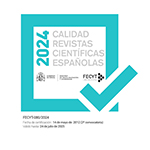Bases para la aplicación de machine learning en el monitoreo y anticipación de crisis alimentarias en Centroamérica
Resumen
El artículo ofrece una detallada y actualizada revisión sobre la aplicación de herramientas de ciencia de datos basadas en algoritmos de machine learning con el fin de predecir a corto y medio plazo la probabilidad de ocurrencia de crisis alimentarias en territorios de países con alta vulnerabilidad a este tipo de situaciones. Tras efectuar un breve repaso sobre la definición de seguridad alimentaria y sus métricas, se describen los principales esfuerzos internacionales para monitorear los factores agroclimáticos, económicos y sociopolíticos que más inciden en el deterioro alimentario de grupos de población o zonas geográficas concretas, y tras ello, generar alertas que desencadenen asistencia humanitaria que impidan el aumento del hambre y sus efectos en la salud de quienes la padecen. A partir de la revisión efectuada se propone un modelo de predicción adaptado al contexto los países Centroamericanos, en el que se consideran variables estructurales a ser utilizadas en la determinación anual de perfiles de vulnerabilidad alimentaria, así como otras sometidas a cambios permanentes y que por tanto permiten identificar shocks o perturbaciones que pueden impactar en la seguridad alimentaria. El modelo propuesto busca mejorar la toma de decisiones y la priorización de recursos y atención humanitaria en regiones con limitada disponibilidad de datos.
Descargas
Descarga artículo
Licencia
La revista Anales de Geografía de la Universidad Complutense, para fomentar el intercambio global del conocimiento, facilita el acceso sin restricciones a sus contenidos desde el momento de su publicación en la presente edición electrónica, y por eso es una revista de acceso abierto. Los originales publicados en esta revista son propiedad de la Universidad Complutense de Madrid y es obligatorio citar su procedencia en cualquier reproducción total o parcial. Todos los contenidos se distribuyen bajo una licencia de uso y distribución Creative Commons Reconocimiento 4.0 (CC BY 4.0). Esta circunstancia ha de hacerse constar expresamente de esta forma cuando sea necesario. Puede consultar la versión informativa y el texto legal de la licencia.












